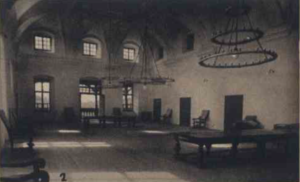Bajmóc

Bajmóc (Bojnice, Bojnický zámok) is located in the Upper lands/Horná Zem/Felvidék, it is in Slovakia. Its castle was built in the 13th century, it was surrounded by a large moat. The castle used to be part of the Borderland castle system in the Kingdom of Hungary. The first builders of the castle were the sons of Comes Kázmér of Hont-Pázmány County.

Bajmóc was first mentioned in 1113 AD. The castle was owned by the mighty oligarch, Csák Máté in 1297. The Hungarian King Lajos (Louis) the Great made Bajmóc a town in 1366. King Zsigmond of Luxembourg gave it to Palatine Comes Jolsvai Leusták. György, the son of Jolsvai died without a male heir so his lands returned to the king in 1427. Bajmóc fell in the hands of Noffri Lénárd and his three brothers in 1430, and they built a strong outer stone castle around the existing one. Bajmóc was one of the few castles that the intruding Bohemian Hussites could not take by siege in the middle of the 15th century.

Later, it was owned by King Matthias Corvinus, who gave it to his natural son Corvin János in 1489. Matthias liked to visit Bajmóc and it was here that he worked on his royal decrees. He used to dictate them under his beloved linden tree, which is now known as the “Linden tree of King Matthias”. He signed many documents there “sub tilia nostra Bajmocensi”. Let us note, that the tree was planted by Lord Csák Máté in 1301.

After his death, the castle became the property of the Zápolya family (also called Szapolyai). But there is a story to that. According to Istvánffy, a chronicler of the 16th century, Lord Szapolyai wanted to assassinate Prince Corvin János. There was a nobleman called Poki Péter who seized Bajmóc castle and regarded it as his own property. When Corvin János was staying at the thermal baths near Bajmóc, Poki closed him out from the castle and hired a few killers to get rid of him. Later, this crime was proven by witnesses, and Poki was sentenced to death, and he was cut into four parts. However, the Szapolyai family took Bajmóc castle away from Prince Corvin because could not pay them a large sum of money that the Szapolyai family allegedly had lent to King Matthias Corvinus.

During the Dual Kingship, King Habsburg Ferdinand gained Bajmóc castle by force from King Szapolyai. The Thurzós, the richest family in the northern Kingdom of Hungary, acquired the castle in 1528 from Ferdinand and undertook its major reconstruction. The former fortress was turned into a Renaissance castle. They reinforced the walls in 1530 in fear of the expanding Ottoman Empire.
The walls served well because the city was burned and sacked by the Ottomans in 1530 and 1599 but the enemy could not take the castle. In the Early Modern Age, it was owned by the Csák family then it had Italian owners who improved the castle a lot. Later the Szapolyai family gained it, and after 1527 it went to the Thurzó family. (Please, note that I use the Oriental name order for Hungarians after the 14th century when family names come first.)

The castle opened its gate to Prince Bocskai István of Transylvania in 1604. The Thurzó family got it back in 1607, though. The Pálffy family took hold of it after 1637 and owned it until the 20th century until 1918. The city was sacked again in 1623 by the Hajdú soldiers of Prince Bethlen Gábor and by Prince Thököly Imre in 1683. The burghers of the town were trading with iron ore, salt, and saffron in the 16th and 17th centuries. It had 607 inhabitants in 1673. It is also known for its spa. The therapeutic springs were mentioned in 1549 for the first time. We know that the troops of Prince Rákóczi Ferenc II could take Bajmóc only by a blockade: the defenders were starving and finally ceded the castle in 1704.

Luckily, the castle was not exploded by the Habsburgs because it was Count Pálffy János who took it back to the Emperor in 1708 by a week-long siege. The loyalty of the Pálffy family saved ten Hungarian castles from destruction.

Finally, the last famous castle owner from the Pálffy family, Count Pálffy Ferenc(1829-1908), made a complex romantic reconstruction from 1888 to 1910 and created today’s beautiful imitation of French castles of the Loire valley. He not only had the castle built but also was the architect and graphic designer. Hubert József, a Hungarian architect from Budapest was working closely with him.

Pálffy utilized his fine artistic taste and love for collecting pieces of art. He was one of the greatest collectors of antiques, tapestries, drawings, paintings, and sculptures of his time in Hungary. There were 80 rooms and 365 windows in Bajmóc in 1889, and more than 6,000 pieces of artifacts were displayed in its collection. The castle burned down in 1945 but later it was nicely restored.

The legend of Bajmóc castle:

Dear Readers, I can only make this content available through small donations or by selling my books or T-shirts.
If you like my writings, please feel free to support me with a coffee here:
You can check out my books on Amazon or Draft2Digital, they are available in hardcover, paperback, or ebook:
https://www.amazon.com/dp/198020490X
or at https://books2read.com/b/boYd81


My work can also be followed and supported on Patreon: Become a Patron!http://Become a Patron!





















































